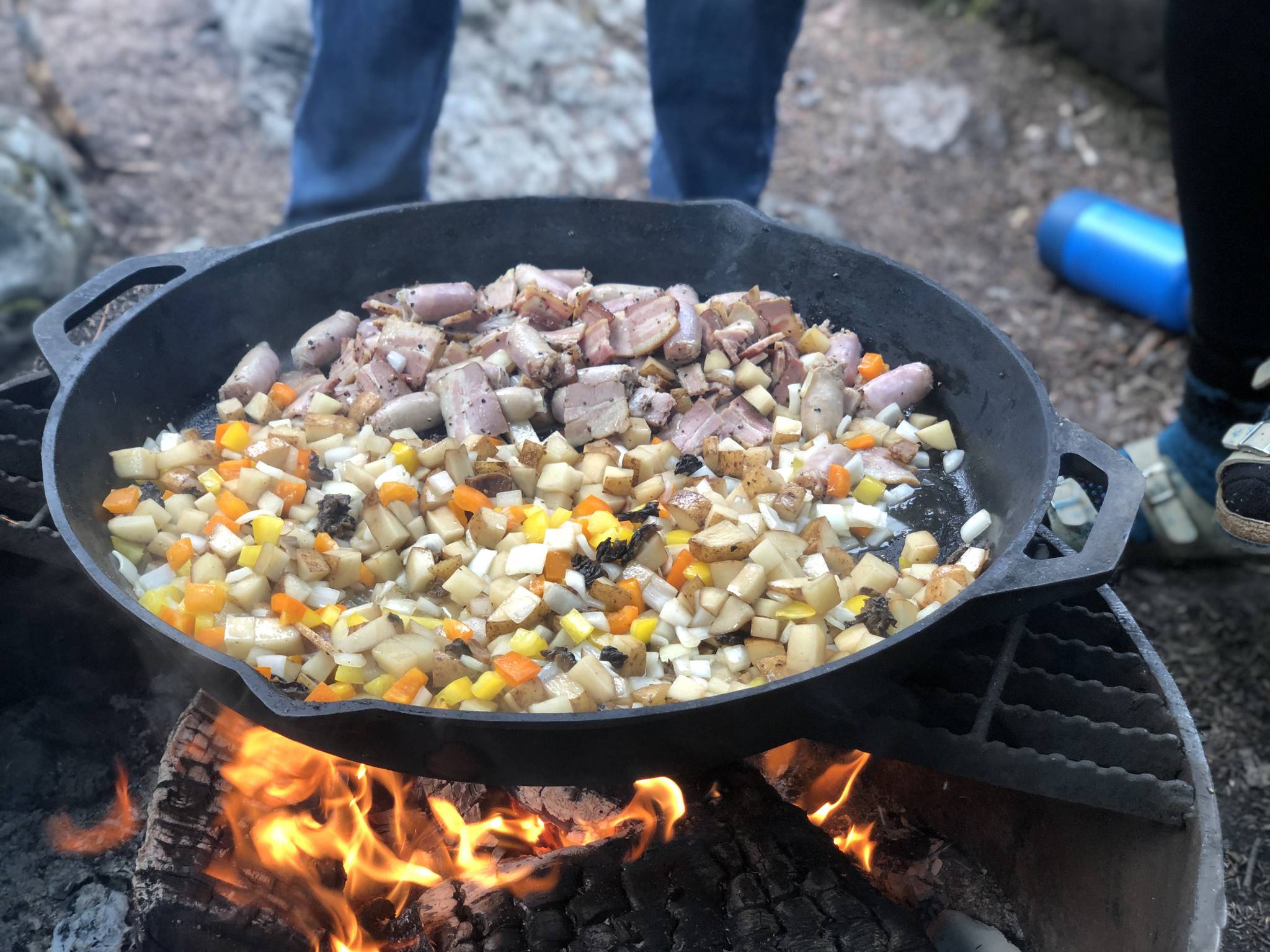With everyone cooped up from a spring spent in quarantine, campgrounds are packed with Alaskans looking to enjoy the midnight sun while staying safe outdoors and practicing social distancing.
My boyfriend and I recently went on a four-day camping trip, which requires some planning — especially when it comes to food.
If you’re driving to a favorite campground — or even a new one — take a moment to research what kind of cooking infrastructure the camping spots have.
Does the campground have a grill, or just a fire pit? If you’re hoping to cook over the fire — which I’m assuming of course you will — there’s a wide and seemingly infinite amount of delicious foods you can cook for yourself and serve to the rest of your camping party.
If the campground you’re staying at doesn’t have a grill rack over the fire, and you want to grill something over the fire, you’ll need to bring a portable rack, a handheld rack (they kind of look like two square tennis rackets with your food squished in the middle of them), some marshmallow or hot dog sticks, or a trusty cast-iron pan.
If you don’t know if the campground has a decent fire pit, or you don’t want to worry about fire cooking, bring a portable camp grill for an easy outdoor kitchen setup.
Important things to bring on your camping trip with you:
A surface to cook on or with (see above)
Any spices you might need for your dishes — at least some salt and pepper. You can put these in small plastic bags, an old weekly medicine dispenser, old Altoids cans, old film canisters, small mason jars or whatever tiny container you have available.
Some sort of fat, either butter or a small bottle of oil or cooking spray, if your dish requires it.
Utensils for eating: fork, knife, spoon and something to stir, flip, ladle and serve your food with.
Plates, bowls, pots or pans — something to eat your food out of. A lot of my friends have special camping plates and bowls, but paper plates work well too and you can throw your plate onto the fire when you’re done.
Bring cleaning supplies to clean any of the surfaces and utensils you’re cooking and eating with.
Bring a can opener, wine opener or a bottle opener if you need it.
All of the food you need for your dish.
Bring lots of water. We have a big blue 5-gallon jug we fill with water and put on the picnic table at the campground or keep in the trunk of the car for easy access so we can brush our teeth, boil some water, refill a water bottle and clean our gear.
The internet is full of creative camp recipes. Some items from the store are made for camping: think s’mores and Jiffy Pop. Most people I know have a special dish they made with their families when they went camping growing up.
My friend Ben loves to use those sandwich fire pans. It’s like two long marshmallow sticks that are hinged at the top with two cast-iron squares where food is placed inside and cooked over a fire. His idea of a quintessential camp treat is to place two pieces of bread inside the pans and pour some canned pie filling inside, squish the two pieces together and hold the cast-iron over the fire.
It’s easy to prepare food before you head to the woods — it can save you time and energy. Last summer, I went camping with a friend near Mount Rainier National Park in Washington. Her go-to campground dinner was a personal taco bag.
Before our trip we went to the store and she picked up ground beef, some shredded Mexican cheese, green onions and cilantro. We got back to her house and made taco meat with onions and put it in a container and threw it in the cooler. When we got the fire started and hunger for dinner set in, she tossed the taco meat onto a pan sitting on the grill of the fire pit to heat it up. While the meat was warming, we slightly crushed up our chips. We opened our Doritos bags and tossed in some shredded cheese and then the taco meat garnished with chopped green onions and cilantro. It’s an easy meal that can be adapted to specific tastes.
My personal attitude toward camp cooking is that you can eat pretty much anything you would normally eat at home, while camping outdoors, without a bunch of unnecessary ingredients or tools.
Think about the simple meals you enjoy at home, and see how you can adapt them for outdoor camping. Obviously some things that use too many kitchen gadgets or need specific and sporadic temperature changes won’t translate well to a primitive outdoor kitchen.
However, a simple breakfast hash with bacon, potatoes, cheese, sausage, chopped bell peppers and morel mushrooms we found at the campground cooked in butter makes a totally feasible, warm and delicious start to your day.
At least it was for us on our latest camping trip.
Victoria Petersen is a home cook who strives to make recipes accessible and as locally sourced as possible. She previously wrote the column from her spacious kitchen off K-Beach Road, but is now working from a small apartment in Anchorage. However, she makes sure to visit friends and family on the Kenai for foraging and fishing.
•By Victoria Petersen, For the Peninsula Clarion

